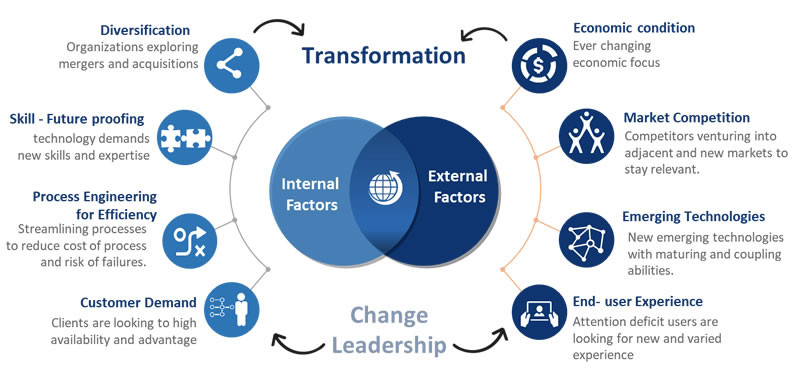In today’s fast-paced and competitive market, businesses must continuously adapt to changes in technology, consumer behavior, and global trends. Business transformation—whether it involves digital innovation, cultural shifts, or operational restructuring—requires not only a clear strategy but also strong leadership to drive success. This article explores why effective leadership is critical during business transformation and how leaders can inspire, guide, and support their teams through change.
The Role of Leadership in Business Transformation

Business transformation often involves significant shifts that challenge traditional processes, mindsets, and organizational structures. A strong leader acts as a catalyst for these changes, ensuring that the vision is clear, the strategy is well-communicated, and the team remains motivated and aligned throughout the process.
Key Roles of Leadership in Transformation:
- Visionary Leadership: Defining a clear and compelling vision for the future.
- Change Management: Guiding teams through uncertainty and resistance to change.
- Empowerment: Enabling employees to embrace new roles, tools, and responsibilities.
- Adaptability: Adjusting strategies as needed in response to feedback or unforeseen challenges.
Why Strong Leadership Matters in Transformation
1. Establishing a Clear Vision and Direction
Transformation begins with a vision—a roadmap that defines where the organization is headed and why the change is necessary. Leaders must articulate this vision in a way that resonates with all stakeholders, from employees to investors. A well-communicated vision provides clarity and ensures that everyone understands the purpose and goals of the transformation.
Key Actions:
- Develop a clear, measurable vision statement.
- Communicate the vision consistently across all levels of the organization.
- Link the transformation goals to the company’s mission and values.
2. Building Trust and Credibility
Trust is the foundation of successful transformation. Employees are more likely to embrace change when they trust their leaders to act in the organization’s best interests. Transparency, honesty, and empathy are essential qualities that help leaders build credibility and foster a culture of collaboration and openness.
Key Actions:
- Be transparent about challenges and progress.
- Actively listen to employee concerns and address them constructively.
- Demonstrate integrity by aligning actions with words.
3. Driving Innovation and Agility
In an era of rapid technological advancements, business transformation often involves adopting innovative tools and practices. Strong leaders encourage creativity, experimentation, and continuous improvement, creating an environment where employees feel empowered to explore new ideas without fear of failure.
Key Actions:
- Champion a culture of innovation and experimentation.
- Provide resources and training for adopting new technologies.
- Celebrate small wins and learn from failures to improve continuously.
4. Managing Resistance to Change
Resistance is a natural part of any transformation. Employees may feel uncertain about their roles, fear job loss, or doubt the organization’s ability to execute the changes successfully. Strong leaders address these concerns with empathy and offer support to help teams adapt to new ways of working.
Key Actions:
- Identify sources of resistance early and address them proactively.
- Provide clear communication about the benefits of change for individuals and the organization.
- Offer support, such as training programs and mentoring, to ease transitions.
5. Maintaining Focus and Motivation
Business transformations can be lengthy and complex, with the potential for setbacks along the way. Effective leaders maintain focus by setting short-term milestones that keep teams motivated and aligned with long-term goals. Recognizing and celebrating achievements along the journey helps sustain momentum and morale.
Key Actions:
- Break the transformation process into manageable phases with clear milestones.
- Recognize and reward team contributions regularly.
- Keep teams engaged with regular updates and feedback sessions.
Essential Leadership Qualities for Successful Transformation
While every leader brings unique strengths to the table, certain qualities are universally important in navigating business transformation:
1. Emotional Intelligence (EQ)
Leaders with high emotional intelligence can understand and manage their own emotions while empathizing with others. This is crucial for building trust, resolving conflicts, and fostering strong team dynamics.
2. Resilience
Transformation often involves setbacks and unexpected challenges. Resilient leaders stay optimistic, adapt quickly, and inspire their teams to persevere through difficult times.
3. Strategic Thinking
Leaders must anticipate future trends, evaluate risks, and make informed decisions that align with the organization’s goals. Strategic thinking ensures that the transformation is not only reactive but also proactive.
4. Communication Skills
Clear and consistent communication is key to ensuring alignment across teams and departments. Strong leaders use storytelling, data, and personal anecdotes to articulate their vision and motivate others.
5. Collaboration
Transformation requires input from diverse perspectives. Collaborative leaders engage stakeholders at all levels, encouraging cross-functional teamwork and shared ownership of outcomes.
Real-World Examples of Leadership in Transformation
Example 1: Satya Nadella at Microsoft
When Satya Nadella became CEO of Microsoft in 2014, he led a cultural and technological transformation that revitalized the company. By shifting focus to cloud computing, fostering collaboration, and emphasizing a growth mindset, Nadella positioned Microsoft as a leader in the tech industry.
Example 2: Indra Nooyi at PepsiCo
As CEO of PepsiCo, Indra Nooyi spearheaded a transformation to align the company with healthier eating trends. Her leadership in introducing more nutritious products and emphasizing sustainability showcased the importance of foresight and adaptability.
Example 3: Howard Schultz at Starbucks
Howard Schultz transformed Starbucks into a global brand by focusing on customer experience, employee satisfaction, and innovative offerings. His leadership emphasized trust, vision, and a commitment to quality.
Steps to Strengthen Leadership During Transformation
Businesses can support their leaders in driving successful transformation by fostering leadership development and organizational alignment.
1. Leadership Training and Development
Invest in training programs that build critical skills such as change management, strategic thinking, and emotional intelligence.
2. Create a Culture of Accountability
Encourage leaders to set measurable goals, track progress, and hold themselves accountable for results.
3. Foster Cross-Functional Collaboration
Provide opportunities for leaders to work across departments, enhancing their ability to drive alignment and manage complex projects.
4. Empower Middle Management
Equip middle managers with the tools and authority to act as change agents, bridging the gap between senior leadership and frontline teams.
Conclusion
Strong leadership is the cornerstone of successful business transformation. Leaders play a pivotal role in shaping the vision, managing resistance, and fostering innovation, ensuring that the organization remains agile and competitive in a rapidly changing environment. By embodying qualities like emotional intelligence, resilience, and strategic thinking, leaders can inspire teams, navigate challenges, and achieve lasting success.
In a world where change is constant, businesses that prioritize strong leadership will be better equipped to thrive and seize opportunities for growth and innovation.





